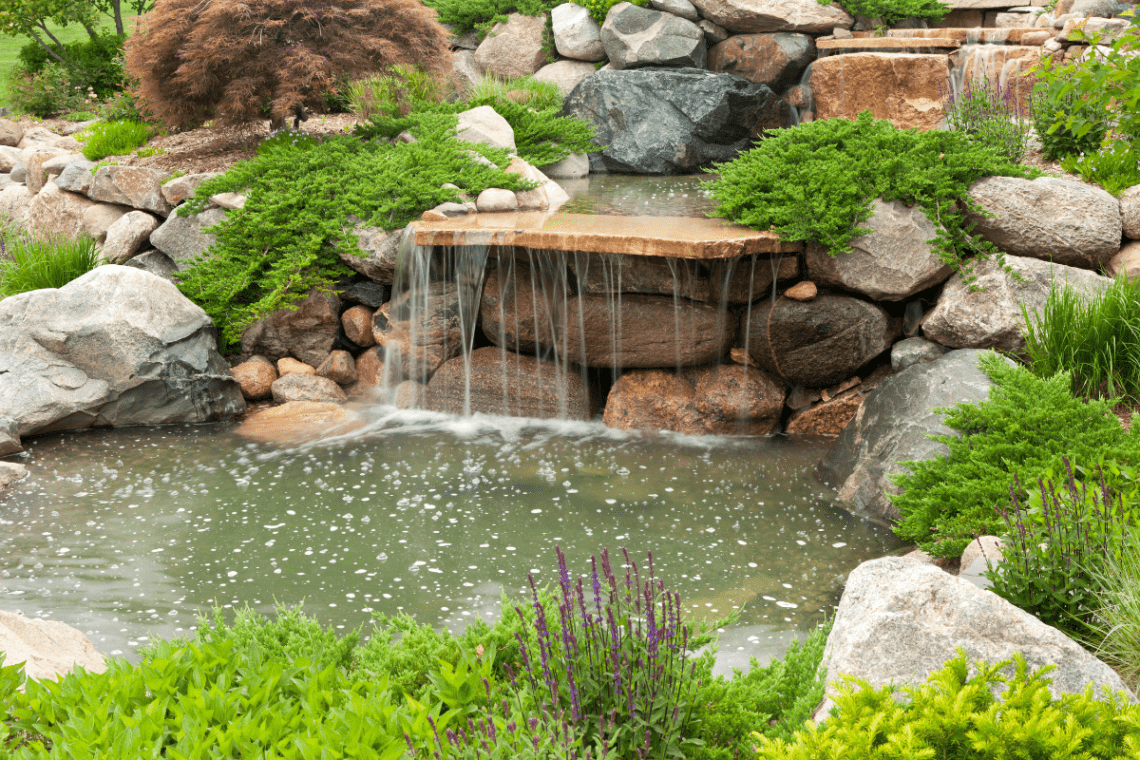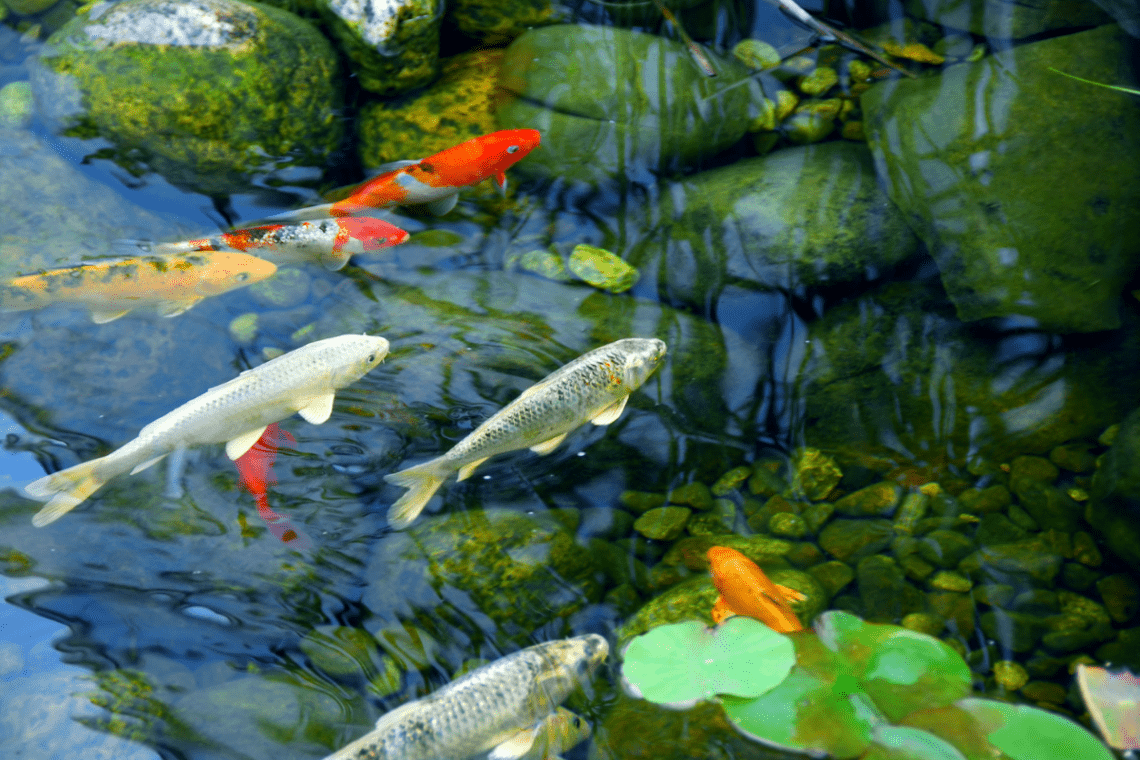In any pond, stones or rocks of some kind are essential. They’re perfect for creating a natural surrounding for your pond and effortlessly blending it into your garden—or, at least, it might seem effortless.
The reality is that you must source, clean, and position each and every stone to achieve a flawless natural look.
Benefits of Using Pond Rocks in Your Pond

Integrating rocks into your pond is not just about enhancing its appeal; they play an important role in maintaining the health and stability of the pond’s ecosystem.
Aesthetic Enhancements
Rocks for ponds are essential for enhancing the visual appeal of a pond, offering texture, colour depth, and a natural feel that mimics wild aquatic landscapes.
With a variety of textures and colours available, rocks can complement any garden theme, from Japanese Zen gardens with smooth decorative stones to rugged mountain streams with sharp, jagged rocks.
Strategically placed large boulders can act as focal points, while smaller stones and pebbles can define the edges of the pond, creating clear borders.
Ecosystem Support
Pond stones and rocks support the ecological balance of a garden pond. They provide habitat for aquatic wildlife, providing shelter and breeding grounds that promote biodiversity.
Rocks also support plant life by anchoring plant roots and protecting them from currents and nibbling fish, which promotes lush plant growth and a healthy habitat.
Additionally, rocks help regulate temperature by absorbing heat during the day and releasing it at night, maintaining a consistent water temperature that is beneficial for both plants and aquatic animals.
Water Quality Management
Rocks contribute to the overall cleanliness and chemical balance of pond water. They can help control algae by shading areas of the pond and reducing the sunlight algae need to thrive, and some rocks naturally balance minerals in the water, helping control algae growth.
The natural filtration process occurs as water flows over rocks, particularly in pond waterfalls or streams, by aerating and filtering the water to remove toxins and improve oxygen levels.
Structural Benefits
Incorporating rocks into a pond also provides structural advantages. Rocks help prevent soil erosion by absorbing the energy of incoming water, such as rain runoff, and keeping the pond edge intact. This reduces sediment build-up and maintains the aesthetic and structural integrity of the pond.
Additionally, they are durable and can withstand harsh weather conditions, offering longevity with minimal maintenance.
How to Choose the Right Pond Rocks

If you’re designing a pond, here are some things you should consider when choosing your rocks:
Size Considerations
The size of the rocks should be proportional to the size of your pond. Large boulders can look out of place in a small pond, while rockery stones that are too small for a large pond might get lost in the landscape.
- Small Ponds: For smaller ponds, look for smaller to medium-sized rocks that can easily be handled and positioned. These can help create detailed landscapes without overwhelming the space.
- Large Ponds: Larger ponds can accommodate bigger, statement rocks, which can serve as focal points. These larger stones can also be functional, acting as natural steps or seating areas.
It’s important to take in the entire look of your garden when considering this, not just the look of the pond. This is the very reason why we have a design stage at Ponds by Michael Wheat. Every pond we build is first designed digitally to show our clients exactly how it will look and fit into their garden.
Texture Matters
The texture of the rocks can add visual interest and serve practical purposes, such as adding grip for walking paths.
- Smooth Rocks: Smooth rocks are typically safer for ponds where children or pets may be present, as they pose less risk of injury compared to jagged rocks.
- Rough Rocks: Rough-textured rocks can enhance the rugged aesthetic of a natural-style pond and are beneficial for microorganisms and algae to stick to, which can help in filtering the water naturally.
It’s important to remember that jagged stones can damage the pond liner, and smooth stones will be slippery when wet.
Design Aesthetic
If you’re going for an architectural feel with slabs, you will need to cut them precisely to your pond’s measurements. For natural-looking ponds, a mixture of different shapes and sizes is best. After all, you don’t want it to look like rubble was dumped around the edge of your pond!
Check out our blog post, Modern Pond Design vs. Traditional Pond Design, for expert tips and ideas.
Consider the Maintenance
Some types of rocks require more maintenance than others. Porous rocks, for example, can hold dirt and algae, requiring more frequent cleaning.
- Low Maintenance: If you prefer a lower-maintenance pond, look for darker rocks that help conceal dirt and algae buildup.
- High Maintenance: Lighter-coloured rocks can require more cleaning as they show dirt and algae more visibly but can be effective in creating bright, reflective qualities in the water.
Whether your rocks come from a garden centre or a dumpster truck, you should always scrub clean any rocks that go near your pond (especially if they’re going into your pond). Skip this step, and you will risk bringing contaminants into your pond, which could potentially be harmful to its inhabitants.
Types of Pond Rocks

Pond rocks can be broadly categorised into two main types: natural stones and artificial rocks. Each type has its own unique characteristics and uses, making them suitable for different styles and functional requirements of garden ponds.
Natural Stones
Natural stones are the most popular choice for pond stones due to their durability and natural appearance, which blend seamlessly into outdoor landscapes. Here are some commonly used natural stones in pond settings:
- Granite: Known for its hardness and variety of colours, granite is a popular choice for ponds as it withstands weathering and maintains its colour over time. It is dense and non-porous, meaning it won’t leach minerals into the pond water that could affect its pH balance.
- Limestone: Limestone is lighter in colour and can help to brighten up shaded pond areas. It’s particularly useful for water features where a more natural look is desired. However, limestone can alter the pH of the water, making it more alkaline. If you have fish or plants that are sensitive to changes in water chemistry, it is recommended to avoid limestone and other calcareous rocks that can alter the pH.
- Slate: Slate chippings offer a rustic appeal with its layered composition and can be found in various shades of grey, green, and blue. It’s ideal for creating waterfalls and ledges within the pond.
- River Rocks: Smoothed over time by flowing water, river rocks have a polished look that is ideal for creating a natural streambed or beach effect in a pond. Their smooth surface also makes them less likely to hold algae and bacteria.
- Fieldstone: Varied in shape and size, fieldstone offers a more rugged aesthetic, perfect for creating a naturalistic look. They are often used to build the edges of a pond or to construct an organic-looking retaining wall.
- Scottish Cobbles: These are an excellent choice for enhancing pond landscapes with their smooth, rounded appearance and variation in colours.
Artificial Rocks
Artificial rocks are manufactured from materials like concrete, fibreglass, or resin. They offer several advantages, particularly in terms of weight and ease of installation. Here are some reasons to consider artificial rocks for your pond:
- Customisable Shapes and Sizes: Manufacturers can create artificial rocks in specific shapes, sizes, and colours, allowing for a high degree of customisation. This can be particularly useful when trying to fit rocks into tight or unusual spaces.
- Cost-Effective: In some cases, artificial rocks can be less expensive than natural stone, especially when considering transportation and installation costs.
- Durability: Made to withstand the elements, artificial rocks will not erode or wear down over time like some natural rocks.
Should You Put Stones In The Bottom Of Your Pond?

This will depend on the type of pond you want and your budget. Here are some things to consider:
Pros:
- Small rocks provide good anchorage for plant life.
- They will give your pond a natural look.
- They create an environment where beneficial bacteria can grow.
Cons:
- The stones can trap waste, creating a sludge that’s challenging to remove.
- They provide anchorage for algae just as much as any other plant.
- You need to regularly clean them. Otherwise, they’ll become hidden beneath algae.
If you plan on having a shallow wildlife pond, we recommend adding pebbles to the bottom. Keep them clean, and the result will be a stunning water feature you can show off in your garden.
On the other hand, if you’re building a fish pond, you should avoid putting stones in the bottom to ensure the pond is fish friendly. It will need more regular maintenance with stones in the bottom, plus fish stand out better in black-bottomed ponds.
Final Thoughts & Wrap Up
All in all, there’s a lot to consider when using rocks in your pond (more than you might realise). But if there’s one takeaway from this post, it’s this: before you commit to a pond build, plan out exactly how your pond will look in your outdoor space and what materials you’ll need prior to everything else.
After all, you wouldn’t plan an extension to your home without proper planning. Why should a pond be any different? At Ponds by Michael Wheat, we are dedicated to guiding you through this process, ensuring that your garden pond not only looks spectacular but also supports a thriving ecosystem. Contact us today to learn more!